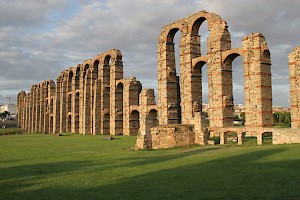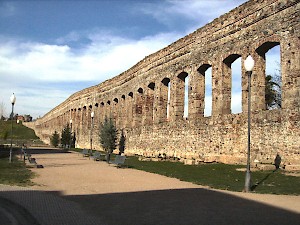Augusta Emerita, Aqueducts
Q3774528Augusta Emerita: Roman city in western Spain, modern Mérida, capital of the province of Lusitania.

Emerita Augusta was a very large city, which needed three aqueducts. The most conspicuous of these is the Los Milagros aqueduct: thirty-seven arches of about twenty five meters high are still standing, made of alternating layers of brick and granite. It gathered its waters at the Proserpina Reservoir, where the small rivers Adelfas and Pardillas were blocked by a dam, built in the second century, that was 21 meters high and 425 meters wide. The aqueduct was once six kilometer long; the structure that is still standing covers one seventh of this distance, 830 meter, and crosses the valley of the little river Albarregas. It was built during the reign of the emperor Augustus.

The second of the three aqueducts is called the San Lázaro. It had its sources - called Casa Herrera, Valhondo, and Las Tomas - to the north and northeast of Augusta Emerita and supplied among others the bathhouse near the Civic Forum in the center of the city. This water conduct was almost completely underground, except for the place where it had to cross the Albarregas; the bridge across the depression is still visible today, northwest of the circus. The Amphitheater House was at the end of this aqueduct. Part of it was restored in the sixteenth century and was in use until the twentieth century.

The Aqua Augusta - the name is known from an inscription - had its source at the Cornalvo reservoir, where rainwater was collected. This was about fifteen kilometer north of the city. It consists of a barrage with a length of 200 meter. It appears to have been built in the fourth quarter of the first century.